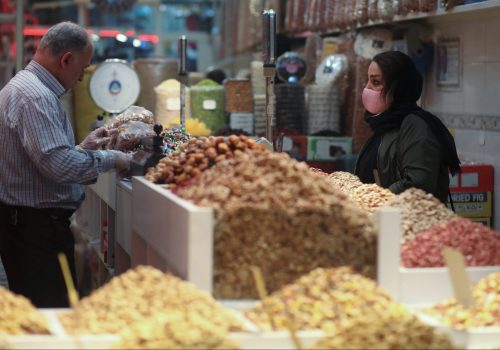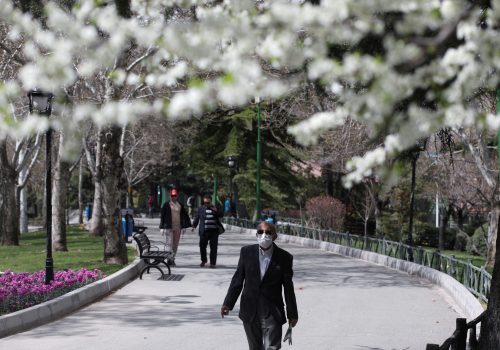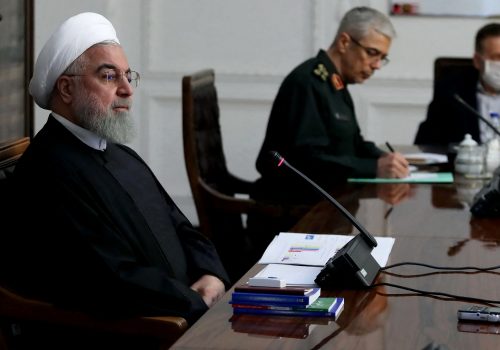Iranian prisoners left behind amid COVID chaos
As the world grapples with the COVID-19 pandemic, international organizations have called on all countries to release the incarcerated, as prisons—where social distancing is not an option—can become hotbeds of COVID very fast.
The United Nations among others has called on Iran to release its nonviolent prisoners from its overcrowded jails. On March 20, Ali Bagheri , Iran’s deputy judiciary chief for international and human rights affairs, said that 100,000 prisoners were, or were about to, be released “conditionally” and that most of them had been incarcerated for owing money or other minor crimes. He did not elaborate on the conditions, but added that the released prisoners would not include “security prisoners,” a term used by Iran’s judiciary to refer to those jailed for alleged political crimes.
Despite Bagheri’s announcement, a number of political prisoners have been among those on furlough since the third week of March. Iranian-British prisoner Nazanin Zaghari-Ratcliffe, Shiraz City Council member Mehdi Hajati, Green Movement leader Mehdi Karroubi’s son Mohammad-Hossein Karroubi, 2009 protest victim’s mother Shahnaz Akmali, and student activist Zia Nabavi, as well as a number of labor activists, were furloughed and remain on temporary release. Ebrahim Ra’isi, Iran’s judiciary chief, said given the current conditions, furloughs should continue until and unless they become a threat to society.
Iran’s judiciary announced on March 30 that all these prisoners’ furloughs have been extended until at least April 16. However, those freed exclude some of Iran’s most prominent political prisoners, including Iranian-American Siamak Namazi and Narges Mohammadi, whose mother has repeatedly expressed concern about her daughter’s health in light of the coronavirus pandemic. Mohammed Hossein Sepehri, a teacher jailed for signing a letter in 2019 calling on Supreme Leader Ali Khamenei to resign, has just contracted the disease.
Iran is now bracing for another wave of COVID patients, largely due to the public’s dismissive reaction to government warnings and recommendations about social distancing and staying at home. Some Iranians still travelled for Nowruz, although the number of people who chose to take Nowruz trips this year was 67 percent less than last year according to government statistics. President Hassan Rouhani has spoken of gradually lifting restrictions to allow “low-risk” economic activity to resume April 11 in provinces and April 18 in Tehran.
Even before the current crisis, the situation in prisons was becoming difficult to manage due to a poor economy and crippling US sanctions. Prisoners, regardless of their crimes or location of incarceration, are terrified of being forgotten or left without medical care. Overcrowding makes them susceptible to contracting COVID-19 and other diseases. Those who remain in prison appear to be at the bottom of the priority list and garnered little attention until March 30 when a large group of Shiraz’s Adelabad prisoners protested a ban on furloughs. Some reports said a number of Adelabad’s inmates escaped, but Kazem Moussavi, Fars Province’s judiciary chief, denied those reports. Meanwhile in Khuzestan Province, the prisoners of Ahvaz central prison reportedly staged a riot; sounds of shooting and thick smoke were detectable from afar.
On March 28, about eighty inmates of Kurdistan Province’s Saghez prison managed to escape, twelve of whom have been recaptured so far. In the past week, a number of prisoners staged a protest in East Azerbaijan Province’s Tabriz prison as well. More inmate protests were reported at Aligoudarz, Fashafouyeh, and Hamedan prisons.
The common point in all these protests and riots—some of which have been violent and have destroyed prison property such as fences and surveillance cameras—is the fact that prisoners are demanding furloughs amid the pandemic and are complaining about the prisons’ poor sanitary situations and lack of medical care.
The situation has also become grist for the information war between the United States and Iran. US Secretary of State Mike Pompeo and his Iranian counterpart Javad Zarif traded jabs recently about poor medical attention and mistreatment of incarcerated citizens in each other’s countries. Meanwhile, although Iran allowed jailed American citizen Michael White out on furlough for medical reasons, the United States did not reciprocate despite Zarif’s call to release Iranians who Iran asserts are unjustly jailed in the United States.
Tehran has repeatedly attributed its problems in treating COVID patients to US sanctions. President Hasan Rouhani described the sanctions and the Trump administration’s refusal to ease up on the restrictions despite the global health emergency as “evil.” On March 20, the US State Department announced that “coronavirus will not save Iran from sanctions.” Officials repeated accusations about Iranian mismanagement of funds and accused the Islamic Republic of prioritizing funding of “terrorism” over the health of its own people. But on April 1, Pompeo said extending sanction waivers might be considered due to the current health crisis, creating some confusion as to whether some relief from US sanctions—or at least a pause in new sanctions—could still materialize.
There is no doubt that Iran continues spends money on military intervention in the region despite the pandemic. However, sanctions also play a role in Iran’s current predicament, as they have depressed the Iranian currency, making all imports more expensive, and have also complicated Iran’s banking relationships with foreign financial institutions. Extending waivers and loosening sanctions might only have a partial impact on the situation but could undercut the Iranian government’s excuses. If Iran’s economy were not in shambles, it would likely have the capability to treat a larger number of people better, and as a result, prisons might be under better sanitary circumstances.
The Iranian government is nontransparent, and has denied or distorted reality time and time again. The truth is that Iranian leaders initially downplayed the COVID-19 pandemic, as did American officials. While some in the Trump administration pointed to President Donald J. Trump’s impeachment trial as a reason for the lack of attention, Iran blames US sanctions. Whatever the reason, ordinary people are suffering—Iranian and American.
Mehrnaz Samimi is a journalist, simultaneous interpreter, and Iran expert in Washington. Follow her on Twitter: @MehrnazSamimi.
Image: A view of beds at a shopping mall, one of Iran's largest, which has been turned into a centre to receive patients suffering from the coronavirus disease (COVID-19), in Tehran, Iran, April 4, 2020. WANA (West Asia News Agency)/Ali Khara via REUTERS


